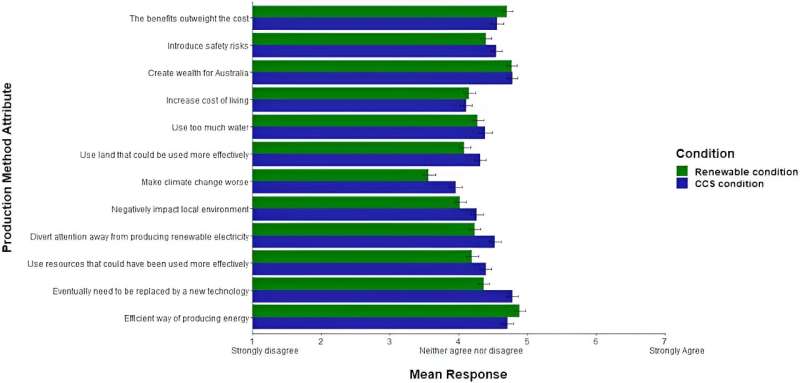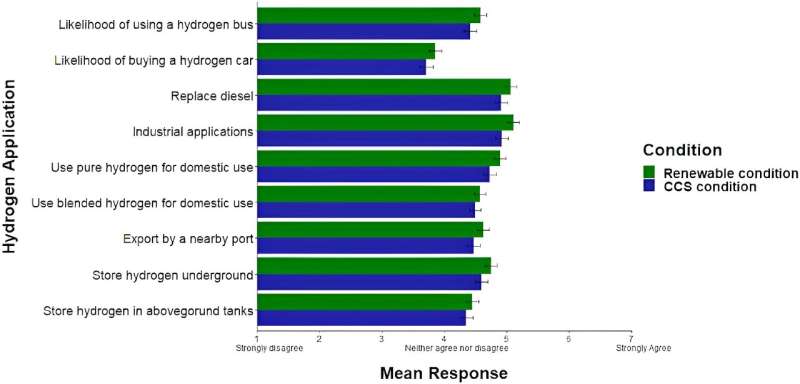

'Green' or 'blue' hydrogen—what difference does it make? Not much for most Austr...
source link: https://techxplore.com/news/2024-02-green-blue-hydrogen-difference-australians.html
Go to the source link to view the article. You can view the picture content, updated content and better typesetting reading experience. If the link is broken, please click the button below to view the snapshot at that time.

February 19, 2024
'Green' or 'blue' hydrogen—what difference does it make? Not much for most Australians
by Mitchell Scovell, Andrea Walton, The Conversation

Hydrogen can play a key role in Australia's energy transition by giving us additional ways of storing and moving energy around. As the world shifts towards cleaner energy production, there's a push to make hydrogen production cleaner as well. In Australia, low-emission hydrogen is produced in two main ways.
One method produces what is known as "green hydrogen". It uses electricity produced from renewables—such as solar, wind or hydro—to "crack" water into separate streams of hydrogen and oxygen.
The other method produces "blue hydrogen". This process separates the hydrogen from a gas mixture obtained from fossil fuels (coal or natural gas), using carbon-capture technologies to deal with the emissions.
While different colors are used to describe these methods, the resulting product is the same: colorless hydrogen. Both methods are technically viable options.
So, we wanted to know what the public thinks about these approaches. Understanding people's attitudes in more detail will help scientists, industry and governments to develop hydrogen technologies in a way that aligns with community values and expectations.
Our survey found only a slight difference in public attitudes to the two methods when they were described without the color "labels". The method of production had little impact on people's willingness to accept different uses of hydrogen.
Why do we need to know what people think about hydrogen?
There is a focus on scaling up the hydrogen industry for many purposes, including transport, heating and industrial uses, in Australia and overseas.
Although there are plans for many new uses, such as powering vehicles, hydrogen has had industrial uses for a long time. At present, it's mainly used to make other chemicals, such as ammonia for nitrogen fertilizer. However, most of this hydrogen is produced globally using fossil fuels, which emits carbon.
Survey participants were shown this animated video.
Now attention has turned to producing low-emission hydrogen. Past research has shown Australians are "cautiously optimistic" about hydrogen's potential as a future fuel. We wanted to explore attitudes to the two low-emission production methods more closely.
Understanding public attitudes is key to promoting responsible innovation for the benefit of all Australians.
How was the survey done?
We asked a representative sample of 1,900 Australians to share their thoughts about living near a hypothetical hydrogen hub—a site where hydrogen is stored, transported and used locally. Participants were told the hydrogen would be produced nearby (200 kilometers away).
We wanted to investigate the effect of the "green" and "blue" production methods on acceptance. To avoid introducing bias, we only explained the technical process of each production method. We did not describe them using colors. Half of the participants were told the hydrogen was produced using one method and half were told about the other method.
Because many Australians aren't aware of hydrogen technologies, we consulted technical experts here at CSIRO so we could provide relevant information about the production methods and their potential impacts. Participants were also shown a short video introduction to hydrogen (shown below) at the start of the survey.
We then asked a serious of questions to assess beliefs, attitudes and levels of support for the production methods and various uses of hydrogen.
A slight preference for 'green'
Participants who were told the hydrogen was produced using renewable energy—"green" hydrogen—had, on average, a more positive attitude to it than those presented with hydrogen made from fossil fuels with carbon-capture technology—"blue" hydrogen. However, the difference between the two groups' overall appraisal of the production methods was quite small.

We also explored the beliefs that underpin these attitudes. Despite some differences in beliefs between the two groups, many of these differences were again quite small. And there were no differences in the perceived influence on cost of living and wealth creation.
The largest difference between the groups was the perceived replaceability of the technology. Blue hydrogen was seen as the more replaceable approach. People also reported blue hydrogen as having a worse impact on climate change and competing more with renewable electricity production.
This article is republished from The Conversation under a Creative Commons license. Read the original article.
Recommend
About Joyk
Aggregate valuable and interesting links.
Joyk means Joy of geeK